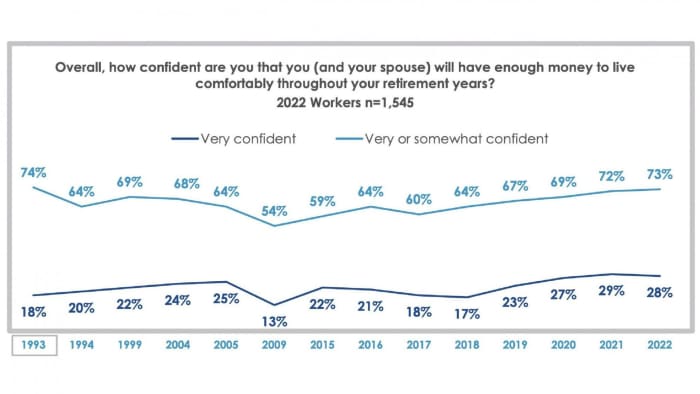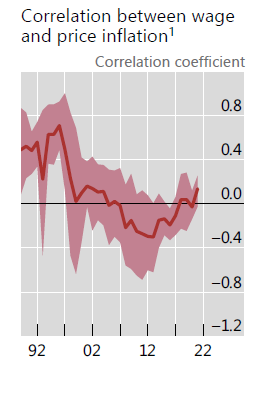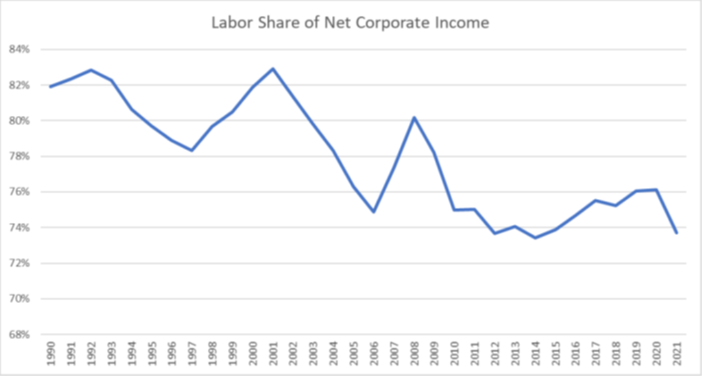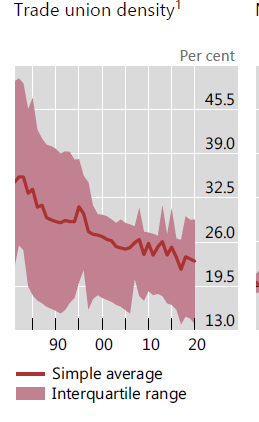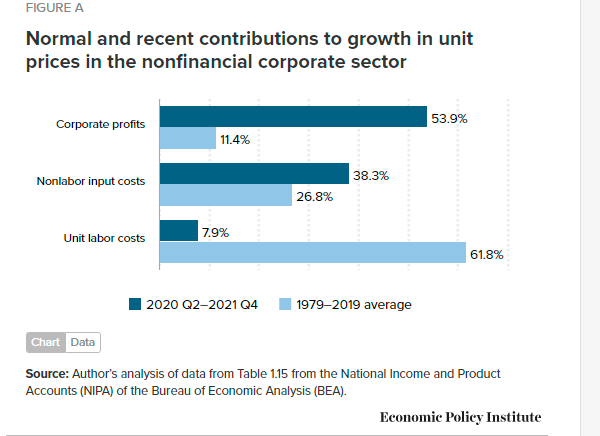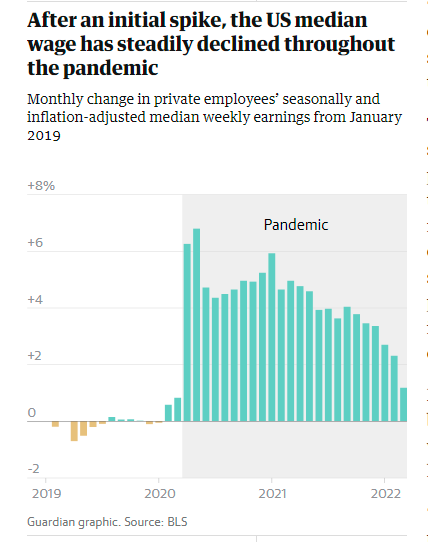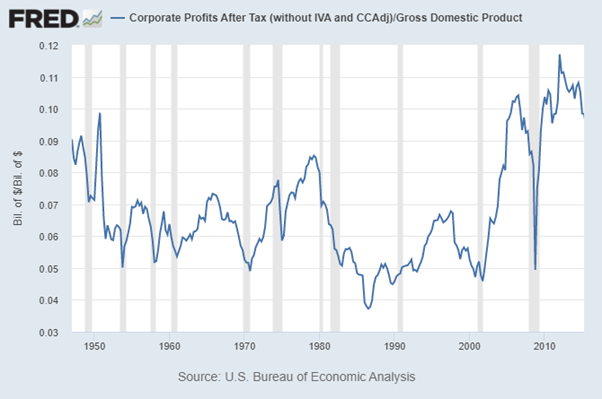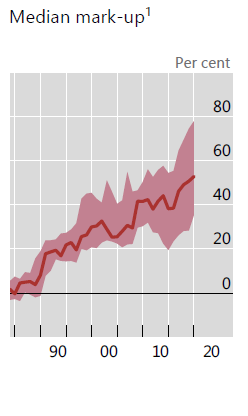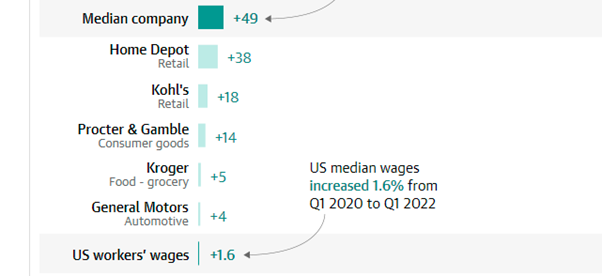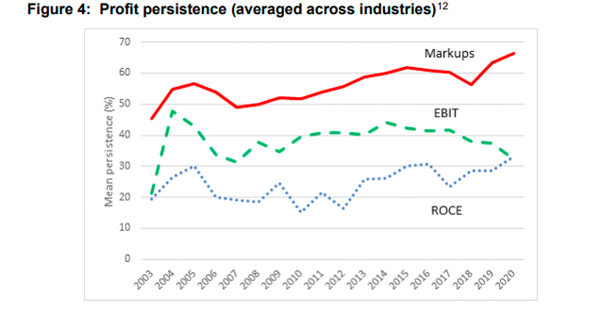Archive for category: Uncategorized
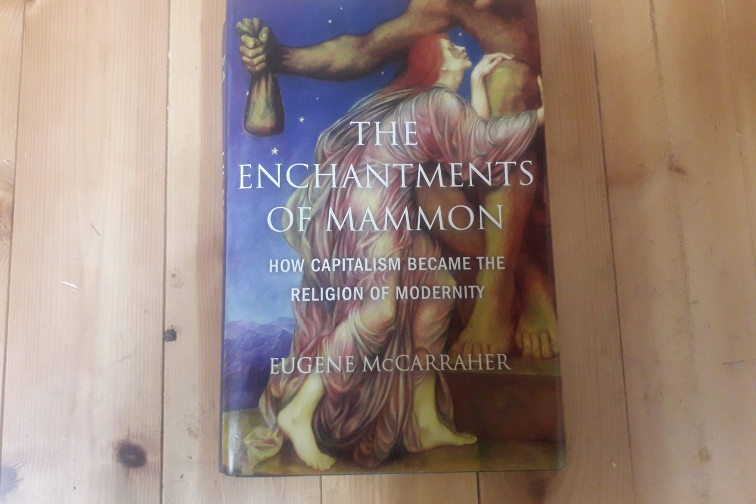
Asking himself how deep the reconstruction of the project of Enlightenment has to go, McCarraher’s answer is an emphatically italicized “all the way down” I think he’s right.
Ishan Desai-Geller

The post When Did the Ruling Class Get Woke? appeared first on The Nation.
The Governor of the Bank of England, Andrew Bailey set the attitude of the mainstream view on the impact of inflation in February, when he said that “I’m not saying nobody gets a pay rise, don’t get me wrong. But what I am saying is, we do need to see restraint in pay bargaining, otherwise it will get out of control”.
Bailey followed the Keynesian explanation of rising inflation as being the result of a tight (‘full employment’) labour market allowing workers to push for higher wages and thus forcing employers to hike prices to sustain profits. This ‘wage-push’ theory of inflation has been refuted both theoretically and empirically, as I have shown in several previous posts.
And more recently the Bank for International Settlements (BIS) study confirms that “by some measures, the current environment does not look conducive to such a spiral. After all, the correlation between wage growth and inflation has declined over recent decades and is currently near historical lows.”
But this wage push theory persists among orthodox Keynesians because they think full employment breeds inflation; and it is supported by the authorities because it ignores any impact on prices by businesses attempting to boost profit. Bailey did not talk about ‘restraint’ in market pricing or profits.
The wage-push theory existed before Keynes. As far back as in the mid-19th century, the neo-Ricardian trade unionist Thomas Weston argued in the circles of the International Working Man’s Association that workers could not push for wages that were higher than the cost of subsistence because it would only lead to employers hiking prices and was therefore self-defeating. For Weston, there was an ‘iron law’ of real wages tied to the labour time required for subsistence which could not be broken.
Marx rebutted Weston’s views both theoretically and empirically in a series of speeches published in the pamphlet, Value Price and Profit. Marx argued that the value (price) of commodity ultimately depended on the average labour time taken to produce it. But that meant the shares of that labour time between the workers who created the commodity and the capitalist who owned it was not fixed but depended on the class struggle between employers and employed. As he said, “capitalists cannot raise or lower wages merely at their whim, nor can they raise prices at will in order to make up for lost profits resulting from an increase in wages.” If wages are ‘restrained’ that may not lower prices but instead simply increase profits.
Indeed, that is what is happening now in the current bout of inflation. In the Great Recession recovery, price growth was actually quite subdued over the first few years of that recovery. Corporations instead applied extreme wage suppression (aided by high and persistent levels of unemployment). Unit labour costs (ie the cost of labour per unit of production) fell over a three-year stretch from the recession’s trough in the second quarter of 2009 to the middle of 2012.
There has been a general pattern of the labour share of income falling during the early phase of recoveries characterized most of the post–World War II recoveries, though it has become more extreme in recent business cycles. By 2019, labour’s share was at all-time low. The decade of the 2010s saw basically a stagnation of average real wages in most major economies.
In a recent report, the Bank for International Settlements (BIS) makes the point that “in recent decades, workers’ collective bargaining power has declined alongside falling trade union membership. Relatedly, the indexation and COLA clauses that fuelled past wage-price spirals are less prevalent. In the euro area, the share of private sector employees whose contracts involve a formal role for inflation in wage-setting fell from 24% in 2008 to 16% in 2021. COLA coverage in the United States hovered around 25% in the 1960s and rose to about 60% during the inflationary episode of the late 1970s and early 1980s, but rapidly declined to 20% by the mid-1990s “
Since the COVID slump, labour’s share of income and real wages have been falling sharply even as unemployment falls. This is the complete opposite of the Keynesian inflation theory and the so-called ‘iron law of wages’ proposed by Weston against Marx. The rise in inflation has not been driven by anything that looks like an overheating labour market—instead it has been driven by higher corporate profit margins and supply-chain bottlenecks. That means that central banks hiking interest rates to ‘cool down’ labour markets and reduce wage rises will have little effect on inflation and are more likely to cause stagnation in investment and consumption, thus provoking a slump.
Prices of commodities can be broken down into the three main components: labour costs (v= the value of labour power in Marxist terminology, non-labour inputs (c =the constant capital consumed, and the “mark-up” of profits over the first two components (s = surplus value appropriated by the capitalist owners). P = v + c + s.
The Economic Policy Institute reckons that, since the trough of the COVID-19 recession in the second quarter of 2020, overall prices in the producing sector of the US economy have risen at an annualised rate of 6.1%—a pronounced acceleration over the 1.8% price growth that characterized the pre-pandemic business cycle of 2007–2019. Over half of this increase (53.9%) can be attributed to fatter profit margins, with labour costs contributing less than 8% of this increase. This is not normal. From 1979 to 2019, profits only contributed about 11% to price growth and labour costs over 60%. Non labour inputs (raw materials and components) are also driving up prices more than usual in the current economic recovery.
Current inflation is concentrated in the goods sector (particularly durable goods), driven by a collapse of supply chains in durable goods (with rolling port shutdowns around the world). The bottleneck is not labour asking for higher wages, shipping capacity and other non-labour shortages. Indeed, in the current inflation spike, US weekly earnings growth has been slowing month by month.
It’s profits that have been spiralling upwards. Firms that did happen to have supply on hand as the pandemic-driven demand surge hit have had enormous pricing power vis-à-vis their customers. Corporate profit margins (the share going to profits per unit of production) are at their highest since 1950.
The BIS study finds similarly: “Firms’ pricing power, as measured by the markup of prices over costs, has increased to historical highs. In the low and stable inflation environment of the pre-pandemic era, higher markups lowered wage-price pass-through. But in a high inflation environment, higher markups could fuel inflation as businesses pay more attention to aggregate price growth and incorporate it into their pricing decisions. Indeed, this could be one reason why inflationary pressures have broadened recently in sectors that were not directly hit by bottlenecks.”
An analysis of the Securities and Exchange Commission filings for 100 US corporations found net profits up by a median of 49% in the last two years and in one case by as much as 111,000%!
Chief executives are acutely aware to the ability to hike prices in this inflationary spiral. Hershey bar CEO Michel Buck told shareholders: “Pricing will be an important lever for us this year and is expected to drive most of our growth.” Similarly, a Kroger executive told investors “a little bit of inflation is always good for our business”, while Hostess’s CEO in March said rising prices across the economy “helps” profits.
Does this mean that companies can raise prices at will and are engaged in what is called ‘price-gouging’? Marx, arguing with Weston in 1865, did not think that was the case in general. The power of competition still ruled. George Pearkes, an analyst at Bespoke Investment, pointed to Caterpillar, which recorded a 958% profit increase driven by volume growth and price realization between 2019 and 2021’s fourth quarters. Eliminating price increases may have dropped the company’s 2021 quarter four operating profits slightly below the $1.3bn it made in 2020. “This isn’t price gouging … and it shows pretty concretely that there’s a lot of nuance here,” Pearkes said, adding profiteering is “not the primary driver of inflation, nor the primary driver of corporate profits”. Indeed, companies that push prices as hard as the current environment allows to maximise profits in the short run may find themselves paying a price in market share down the road as others get into the game. It is clear, however, that the concentration of capital is any sector, the greater ability to hike prices. “When you go from 15 to 10 companies, not much changes,” one analyst argued. “When you go from 10 to six, a lot changes. But when you go from six to four – it’s a fix.”
Recently, the UK’s Competitions and Market Authority (CMA) published an important report. The CMA found a mixed picture.Profit persistence has increased as measured by markups over marginal costs and the return on capital but not when measured by profits before tax.
And the CMA also found that the more international competition there was, the less ability for firms to increase prices and mark-ups. “This highlights the important role that international trade plays in contributing to keeping UK markets competitive.” The BIS summed up this debate: “In product markets, the degree of competition comes into play. Firms with higher markups – an indication of greater market power – could raise prices when wages increase, while those without such pricing power may hesitate to do so. Strategic considerations in price-setting are also relevant. Firms may feel more comfortable raising prices if they believe their competitors will also do so. Price increases are more likely when demand is strong. With less concern about losing sales and less room to adjust profit margins, even firms with less pricing power could pass higher costs through to customers.”
As a partner in the Bain consultancy, an adviser to many corporations, argued, “when times are tough, screw your customers while the screwing is good!”. The consultant went on: “I don’t think this is actually nefarious at all. Companies should charge what they can. Profit is the point of the whole exercise.”
This year is on track for record lobbying spending after lobbyists collectively clocked the biggest first quarter haul in history — with more than $1 billion disclosed during the first quarter of 2022 alone.
At this point in 2021, 10,503 lobbyists had brought in less than $929 million across all industries.
The federal budget was the most lobbied issue from January through March, with 3,394 clients paying for lobbying on the issue. Health issues were also heavily lobbied, with 2,068 clients.
Lobbying related to health continues to dominate spending as recovery from the coronavirus pandemic continues.
The health sector accounted for about $187 million in this year’s first quarter and $689 million over the course of 2021. Of the 3,130 lobbyists working for the health sector last year, nearly half — 47.8% — had taken a swing in the revolving door as former government employees.
Within the sector, the pharmaceuticals and health products industry continues to be a top lobbying spender as various companies fight drug pricing regulations, grapple with supply chain issues and seek approval for vaccinations.
Pharmaceutical Research & Manufacturers of America ranked third overall in the first quarter of 2022 with nearly $8.3 million in spending during that period. The pharmaceuticals industry trade group was the third largest lobbying spender of 2021 at over $30 million for that full year.
Blue Cross/Blue Shield is the fourth highest lobbying spender overall with about $7.6 million in the first quarter of 2022. The health insurance company spent over $25 million on lobbying last year, making it the fifth biggest lobbying spender overall in 2021.
The American Hospital Association and the American Medical Association are also major lobbying spenders with about $6.6 million in spending from each during the first quarter of 2022. The associations were also neck and neck in 2021 with their national associations spending about $20 million each on lobbying over the year, putting them among the top spenders. Along with its state affiliates, the American Hospital Association’s federal lobbying spending topped $25 million in 2021.
America’s Health Insurance Plans spent another $4.7 million on lobbying in the first quarter of this year, more than any prior quarter in the health insurance industry trade group’s history.
Biotechnology Innovation Organization spent nearly $3.2 million on lobbying in the first quarter of this year, falling lower among the ranks of lobbying spending but remaining a powerful influencer for the biotechnology industry.
Lobbying Stalwarts Continue to Top Spending Charts
While the health industry dominates overall, the top spender of this year’s first quarter was the U.S. Chamber of Commerce with about $19 million in lobbying spending.
A longtime top lobbying spender with more than $1.7 billion spent since 1998, the Chamber spent over $66 million on lobbying in 2021 alone. The business lobbying group’s heavy spending made it the top lobbying spender of 2021 despite fallout among Republicans after the Chamber’s endorsement of 30 Democrats seeking House seats in 2020, which led to several key officials parting ways with the group and criticism from GOP lawmakers.
The Chamber is also a big spender on elections, spending millions on ads targeting politicians it may later lobby. During the 2020 election cycle, the Chamber’s spending on electioneering communications – which can boost and attack candidates without explicitly advocating for their election or defeat – topped $5.7 million.
The National Association of Realtors was the second highest lobbying spender with over $12 million in the first quarter of this year.
The Realtors association was also the second highest spender in 2021 as it faced further scrutiny from the Justice Department related to antitrust issues, pouring about $40 million into lobbying spending over the course of last year. The association’s 2020 lobbying spending topped $84 million, the largest amount the association has spent on lobbying in any single year, and more than any other organization spent on lobbying that year.
While the association’s lobbying spending dipped in 2021, it has a history of dropping in non-election years. The association’s $12 million in first quarter spending is over $4 million more than it spent on lobbying during the same period last year but still about $1.5 million less than it spent during the first quarter in 2020.
Like the Chamber, the National Association of Realtors also spends to influence U.S. elections directly, along with its affiliated political groups, pouring more than $20 million into 2020 spending.
Technology companies were also among the top 10 lobbying spenders of 2022’s first quarter.
Facebook’s parent company, Meta, spent nearly $5.4 million on lobbying while online retail giant Amazon spent over $5.3 million.
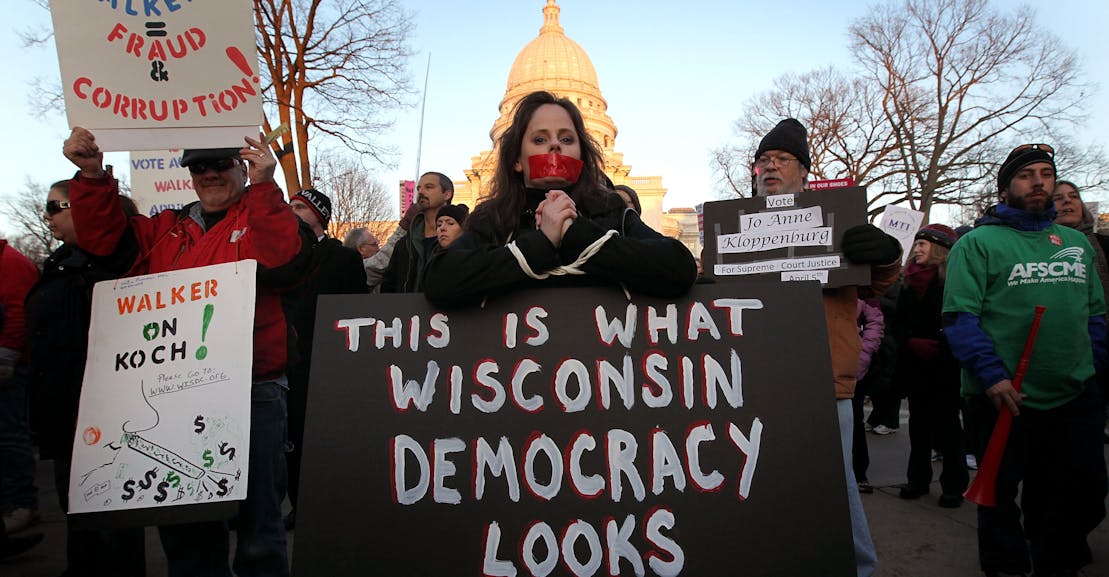
With an eye to this November’s
elections, Paul Spink—like many union leaders in Wisconsin—plans to do his utmost this year to salvage what’s left of
democracy in his state. Spink, president of
the American Federation of State, County and Municipal Employees, or AFSCME, in
Wisconsin, says it’s vital to reelect the state’s Democratic governor, Tony
Evers, to preserve some semblance of majority rule in Wisconsin and to keep
some check on what he sees as a runaway Republican legislature that is pushing
hard to lock in GOP rule for the next 10 years.
“It’s really hard to use the term ‘democracy’ to describe what’s happening now in Wisconsin,” Spink said. “It has
been years of them trying to undermine the idea of having average people pick
their leaders.”
In 2010, a year when the GOP made major gains in state races across
the nation, Republicans won control of Wisconsin’s governor’s mansion and both
houses of its legislature. The next year, Republicans approved a gerrymandered district map that ensured continuation of the
GOP majority in both legislative houses in election after election, even when
Democrats won a majority of votes statewide in legislative races. Spink
complains that Wisconsin’s Republicans are now parlaying that decade-old
gerrymander into a more egregious one aimed to lock in a veto-proof majority.
Spink is outraged that Wisconsin’s
Republican legislature—aided by a ruling from the United States Supreme Court’s hard-right
majority—pushed through a redistricting plan that aims to give the GOP veto-proof,
two-thirds control of
the State Assembly and Senate even though
the Democrats won all five top races for statewide office in 2018. Spink said that if the Republicans win either the governorship or a veto-proof legislative majority in November,
“we’ll see them passing more and more laws to make it so they’ll never lose
power.”
Noting Wisconsin’s progressive,
labor-friendly past—it was the first state to enact
unemployment insurance, for example—Spink
added, “We used to be a laboratory of democracy. Now we’ve become a laboratory
of autocracy.”
Spink, a 43-year-old Milwaukee resident, became head of
AFSCME in Wisconsin in 2015, after years working as a state employee who
inspected childcare centers for safety. Spink typically talks with a calm
demeanor, but when he turns to the precarious state of democracy in Wisconsin,
frustration and anger quickly seep into his voice.
“In recent months,
there’ve been at least five or six bills the
legislature passed to limit voting rights and undermine
elections,” Spink said. “We’re trying very hard to keep a Democratic governor
in this state to block those.”
When John Johnson, a Marquette
University law professor, analyzed the GOP’s voting map this April, he
predicted hugely skewed results for this November: that Republicans would win 63 out of Wisconsin’s 99 Assembly
seats and 23 out of 33 Senate seats—this in a state with a population that is
widely viewed as being split 50–50 between Democrats and Republicans. Gerrymandering of
this magnitude is unhealthy in a democracy; not only does it disadvantage
certain blocs of voters over others, diluting the power of their votes, it also
undermines the validity of the resulting government itself. Spink very much hopes that organized labor and its allies
will—by helping Democrats win enough of the
few legislative districts that remain competitive—manage to block the GOP’s ambitions to secure a veto-proof
majority in both houses.
Spink aims to mobilize hundreds of AFSCME
members to knock on doors, do phone-banking, and speak to fellow employees in
the workplace to explain that democracy is on the line and that Republican
politicians, from Donald Trump on down, have delivered far more to corporations
and the wealthy than to the nation’s workers. “It’s up to me and people like me
to beat the odds in some of these districts,” Spink said. “We’re going to have
to run a better political program than we have before. It will be all hands on
deck.”
Making Spink’s political efforts
tougher, back in 2011 Wisconsin’s then-Governor Scott Walker and the
Republican-led legislature enacted a landmark anti-union law that aimed to
cripple most of the state’s government employee unions by creating several
hurdles that made it harder and more expensive for union locals to survive.
(One of those hurdles is a hard-to-win annual recertification vote with rules
stacked hugely against unions.) As a result of that law, AFSCME’s Wisconsin
membership has plummeted to just 10,000 from over 50,000 a decade ago. Indeed,
largely as a result of that 2011 law and other measures to weaken unions,
Wisconsin’s union membership has plunged by 170,000, or 44 percent, since 2009, with the percentage of workers in unions falling to 7.9 percent from 15.2
percent—the steepest drop of any state. Wisconsin’s Republicans recognized that by weakening
labor unions and their treasuries, they would undermine the Democrats’
electoral chances.
Spink said, “We’ll just have to
punch above our weight when it comes to the total number of doors we’re going
to hit and the calls we’re going to make and some of the checks we’re going to
write.”
The GOP push to undermine majority rule by minimizing the
political voice of unions and minority voters will hurt Wisconsin’s workers,
Spink says. He predicts
that veto-proof Republican control will mean new legislation to increase child
labor and little effort to modernize the state’s balky unemployment insurance
system. Wisconsin Republicans have proposed letting 14-year-olds work until 9:30 p.m. on school days and until 11:00 p.m. on non-school days.
“If we don’t have democracy,” Spink
said, “there is no fairness for working people.”
The need for a nationwide effort
Across the nation, many labor leaders share Spink’s alarm
about preserving democracy as well as his goal of punching above one’s weight
in this year’s elections. They view this year’s election and 2024’s with dire urgency, as
a goal-line stand to defend America’s democracy;
and they also understand that, thanks to
organized labor’s ability to mobilize tens of thousands of foot soldiers,
America’s unions, with their 14 million members, are one of the nation’s most
potent and effective political forces.
Labor unions typically focus on
presidential and congressional races, but this year, in Wisconsin and
elsewhere, they plan to focus far more than usual on state and local races—for instance, to defeat Republican
candidates for elections commissions and secretaries of state who support
Trump’s “Big Lie” and who have suggested they will overturn their state’s vote
results in 2024 if the Democratic presidential nominee comes out ahead.
Political scientists say unions can
play a big role in preventing Trump and other Republicans from subverting
America’s democracy. “Unions are a huge mobilizer,” said Paul Frymer, a
political science professor at Princeton. “They’re one of the biggest
mobilizers for the Democratic Party, maybe the biggest.”
Shane Larson, director of government affairs for the
Communications Workers of America, sees a big attitude shift among union
leaders—to far greater
urgency. Larson said that many labor leaders, as usual, wanted to focus
overwhelmingly on jobs and other economic matters and weren’t paying much heed
to warnings that America’s democracy was threatened. January 6, 2021, was a huge “wake-up call” to those union leaders,
Larson said.
Now, he said, “the conversation among union presidents is
that our movement has to do something here for our democracy or we can lose
it.” Larson added
that part of labor’s focus this year “is to hold accountable a number of insurrectionists running for some of
these offices.”
Randi Weingarten,
president of the American Federation of Teachers, said some union leaders,
along with many Americans, “still
don’t have the imagination to believe that this [the destruction of democracy]
could happen in America. There’s a sense that our democracy is so well rooted
that nothing will dislodge it. If there is one thing that I could help change
right now, it is for people to have the sense of imagination that it could
happen here. Once you lose a certain number of democratic institutions, it’s
very hard to get them back.”
Ensuring broader participation
America’s labor unions are pursuing
two interlocking strategies in their effort to protect and preserve America’s
democracy. One strategy is to battle against efforts that would reduce the
voice of minority voters, make it harder to vote, and empower Trump partisans
to twist and even overturn vote counts. The second strategy is to make sure
that Democrats win pivotal states, especially longtime union strongholds, such as Michigan, Pennsylvania, and
Wisconsin, but also states that have more recently moved from red to blue, such
as Arizona, Georgia, Nevada, and Virginia.
“For me, protecting democracy right now means
rebuilding the blue wall in Michigan, Wisconsin, and Pennsylvania,” said Steve
Rosenthal, a former AFL-CIO political director. “Without those states, there is no
way that Donald Trump or the next Donald Trump or any anti-worker candidate
could win in 2024.”
In Rosenthal’s view,
if union households totaled 25 to 30 percent of the vote in those three
industrial states, as they did 25 years ago, instead of
totaling 15 or 20 percent, as they do today, Trump would never have won
Michigan, Pennsylvania, and Wisconsin in 2016—and with them the election. Nor would he be able to win those states again in 2024.
There are hundreds of thousands of former union members in those three states,
who are no longer contacted by their union, who no longer receive union
political literature, who no longer have union members knocking on their doors,
and that, many political experts say, helps explain why Trump was able to
narrowly win those three states in 2016. (Many unions were so confident that
Hillary Clinton would win those states that they didn’t mount nearly as much of
a campaign effort as they might have.)
For many labor leaders and
Democratic lawmakers, a major concern is that many blue-collar workers—union members, former union members, and
nonunion workers—have gotten swept into a
right-wing echo chamber that amplifies the messaging from Fox News, Sinclair Broadcasting, Breitbart, Mark Levin,
Charlie Kirk, Sean Hannity, and Tucker Carlson. “Where we’re failing is with
the right-wing sound machine and echo chamber—their
message is constantly reinforced,” Larson said. “We have to figure out, how are
we going to counter that story? The one thing we
know is that workers value their union as an information source. In a time when
people don’t trust information sources, we’re constantly finding they see their
unions as a valid source of information—even
if workers don’t agree all the time with their union.”
Rosenthal has founded
a group, In Union, that aims to
counter the right-wing echo chamber and give blue-collar workers accurate
information on what’s happening in the economy and what various candidates
stand for. His group keeps in regular contact with hundreds of thousands of
former union members in Michigan, Pennsylvania, and Wisconsin. Those voters
perhaps lost their union membership when their steel mills or auto plants
closed and they lost their jobs. In Union sends emails and texts, mails
newsletters, and knocks on doors to talk to voters about issues months in
advance of elections and then holds long conversations at voters’ doors closer
to the election about which candidates are pro-worker and which aren’t.
Throughout 2020, In Union was in regular contact with 1.2 million voters in
Michigan, Pennsylvania, and Wisconsin (including many nonunion voters who
surveys show share the views of union members). Rosenthal hopes to get funding
to reach out to another three million nonunion voters in the coming months.
With money from
unions, foundations, and individuals, his group seeks to build trust with those
voters and explain, for example, as it did during the 2020 election, how Joe
Biden would do more for workers than Donald Trump would. A
recent In Union newsletter for Pennsylvania voters explains what new
infrastructure investments will mean for Pennsylvania and how Biden’s new rules
mandate that the federal government use its powers to buy American-made goods.
Jacob Grumbach, a political science professor at the
University of Washington, says unions can play an important role in offsetting
the GOP’s repeated use of cultural issues such as transgender rights and critical race theory to create “moral
panics” in order to get blue-collar workers to vote
Republican. “They often vote now based on anti-immigrant views and culture-war
issues,” Grumbach said, “but compare that becoming a priority to how people
voted when unions were the main organizing force for the working class.”
Grumbach said the Biden administration recognizes the
political advantages of strengthening unions. “Hopefully it’s not too little too late,” he said. “It’s
crucial for the Democrats to have this long-term base to structure politics
around material circumstances [such as housing
affordability and access to childcare] rather than around a cultural war.”
Many labor leaders say Democratic lawmakers have
unwittingly undermined their party’s chances by doing so little in recent
decades to stop unions’ membership and clout from declining. More than 20
percent of all workers were in unions in the 1980s, but that has fallen to just
10 percent today.
“For a long time, the Democrats have ignored just how
important unions are to represent workers and raise salaries—and how important they are to the
Democratic Party for winning elections,” said Princeton’s Frymer. “They let the union decline happen right before their eyes.
They didn’t do anything to stop it. They let their coalition decline.”
Over the past 50 years, the Democrats have repeatedly failed to enact
legislation to make it easier for unions to grow. Democratic lawmakers are
quick to note that Republican filibusters blocked efforts by Presidents Carter,
Clinton, Obama, and Biden to make it easier to unionize.
While labor leaders often criticize Carter,
Clinton, and Obama for not doing enough to strengthen unions, they give higher
praise to Joe Biden. Biden and his administration seem eager to reverse the
decline in union membership and union power, all while many Republicans are
clearly intent on hastening labor’s decline. Biden has vigorously backed the
Protecting the Right Organize, or PRO, Act, one of the most comprehensive
pieces of pro-union legislation since the New Deal. But that legislation, which
the House has approved, has stalled in the Senate, not just because of a
Republican filibuster but because several Democratic senators have opposed it,
undermining efforts to get even a simple majority of senators to back it.
It is well known that unions boost election prospects for Democratic candidates by
educating union members on issues and getting out the vote through door knocking
and phone banking. But unions help the Democrats in other important ways.
Various academic studies have found that unions help discourage workers from
backing right-wing populists such as Trump who
appeal to worker resentment. Unions help prevent workers from growing resentful
and alienated by delivering economic gains, by rooting workers in social
networks, and by reducing racial resentment among white workers. Unionized workers are more prosperous than nonunion
workers in comparable jobs. They earn more; receive better health coverage and
pensions; and have more job security, vacation days, and paid sick days.
A study of union
members by Frymer and Grumbach found that by bringing
workers of different races together and having them cooperate in pursuit of
common goals, unions reduce racial resentment. “White
union members,” they write, “have lower racial resentment and greater support
for policies that benefit African Americans.” As a candidate, Trump milked many
white workers’ racial resentment to win their support.
Unions have long played a big role reaching that
much-analyzed, much-discussed demographic: blue-collar whites. That group was
key to Franklin Roosevelt’s New Deal coalition but has moved sharply away from
the Democrats in recent years. Unions have tempered that shift, however. Frymer
and Grumbach found that white union members vote eight to 14 percentage points more for Democrats than do white nonunion members. This
more Democratic
tilt among white union members accounted for 1.7 percentage points of Obama’s victory margin in 2008 and again in 2012, several studies have found.
“Unions remain the
only set of organizations in the U.S. that can help prevent working-class
whites from going conservative,” said Jake Rosenfeld, a sociology professor at
Washington University in St. Louis. While Trump often boasts that he did
well among union members, Rosenfeld reminds us that Trump lost among union
members in both 2016 and 2020.
It is often forgotten
that unions frequently
educate and engage typical Americans in the basics of
democracy and civic activism. In that way, unions help to get many
nonaffluent Americans involved in politics, and that, at least somewhat,
offsets the disproportionate political voice that corporations and the wealthy
have thanks to their lobbying and hefty campaign donations. Robert D.
Putnam, author of Bowling Alone, has
praised unions for building an important sense of community—with their meetings, marches, protests, and
picnics—and for serving as “schools for
democracy,” where workers get involved in everything from collective bargaining
to debates in union meetings to canvassing in political campaigns.
Alexander Hertel-Fernandez, a political science professor
at Columbia University who is overseeing some research for the Labor Department, said, “Unions serve as a school for democracy for citizens by
introducing individuals, particularly those who might not be involved in other
civic organizations, to the rhythms of democracy.”
The ground game
When it comes to
fighting to defend democracy, Unite Here, a 300,000-member union of hotel and
restaurant workers, has perhaps punched above its weight more than any other
union. It was a principal sponsor of a modern-day “Freedom
Ride,” in which 1,500 hotel housekeepers, dishwashers, and other
union members were bused into Washington along with Black Lives Matters
activists and other allies to press Congress to enact new voting rights
protections. In Arizona, Unite Here co-sponsored a hunger
strike to pressure Senator Kyrsten Sinema to enact voting rights legislation.
The union also posted videos and ran full-page newspaper ads to press Arizona’s
Republican legislature not to roll back voting rights, and it pushed Arizona
lawmakers to condemn Cyber Ninjas’ much-derided review of the presidential
vote.
Other unions have
also done their best to dissuade GOP-led state legislatures from making it
harder for people to vote, but that’s an uphill battle in deep-red states where
many lawmakers have swallowed Trump’s lie about widespread voter fraud. In
Georgia and Texas, the Service
Employees International Union ran internet ads that criticized Coca-Cola, Delta
Airlines, Home Depot, and other corporations for donating to lawmakers who
backed new voting restrictions. AFSCME, the National Education Association, and the American
Federation of Teachers held rallies in Washington, Cleveland, Milwaukee, and
Detroit to defend the right to vote
and protest efforts to make it harder for Americans of color to vote. AFSCME also provided plaintiffs in lawsuits
that have challenged new laws that it says
illegally discriminate against and disenfranchise voters of color. Many unions are urging their members to serve as poll
watchers in communities where they fear that Trumpist poll watchers will seek
to intimidate voters of color.
At the same time, AFSCME and other unions are educating people about how to make
sure they can vote despite all the newly enacted voter restrictions, such as
laws cutting back on early voting, drop boxes, and Election Day registration.
“We’re not going to sit back and assume the courts are
going to help us out,” said Brian Weeks, AFSCME’s national political director. “We assume that we will
have problems, and we’ll make sure that our program helps overcome that.”
In recent months, teachers unions have fought a different
type of battle to defend democracy—often by fighting against book bans and defending teachers who face punishment for teaching about
racism. “In many countries, labor
unions have been a bulwark against authoritarianism,” said Weingarten of the
American Federation of Teachers.
Weingarten said her
union might endorse some non-Trumpist Republicans, such as Lynn Cheney, who
reject the “Big Lie” and Trump’s efforts to overturn election results. This
means that in districts where Democrats have little chance of victory, the
teachers union might help elect Republicans who oppose the GOP’s increasing embrace
of authoritarianism.
For the 2020 elections, Unite Here ran a huge
door-knocking operation that some political experts say could serve as a model
for the overall labor movement.
That
union had 500 full-time canvassers going door to door in Nevada and another 500
doing the same in Arizona. Unite Here says its canvassers contacted 48,364 infrequent voters in
Arizona who did not vote in 2016 and
urged them to back Biden. The union says that helps explain why Biden won
Arizona by 10,457 votes, a victory that surprised and shocked the Trump forces.
Many of Unite Here’s canvassers were hotel workers who were laid off during the
pandemic, and their union, often helped by funds from other unions, paid them
about $700 a week to canvas.
All told, Unite Here says its canvassers knocked on three million doors in Arizona, Florida, Nevada, and Pennsylvania in 2020 and talked
with more than 460,000 infrequent voters. Its canvassers did so well in those
states that Stacey Abrams asked Unite Here to send its canvassers to help push
Raphael Warnock and Jon Ossoff over the top in the Senate runoff in Georgia. The union says it sent 1,000 canvassers to
Georgia from Arizona, Nevada, Pennsylvania, and other states.
Chris Smith, a
53-year-old Unite Here member who works as a bartender in San Diego, spent six
weeks canvassing in Georgia. “People whose doors I knocked on, they
got excited,” Smith said. “They asked me a lot of questions. I felt I was
making a difference, that I did matter. We were going to turn the Senate away
from the bullying Republicans.”
Susan Minato,
co-president of Unite Here’s giant union local in Southern California and
Arizona, sees her union’s effort as an example for all of labor. “I want other
unions to have more people canvassing in these races, to do it in every state,”
she said. “That would be huge.”
Gwen Mills, Unite
Here’s secretary-treasurer, said the union’s goal is to have 1,500 union
members canvassing in key races this year, “going door to door, reigniting people to vote.” Mills said, “We try to keep a drum beat year
in and year out: Do democracy at work, do democracy at the doors, do democracy
at the polls, do democracy in the capital.”
With Stacey Abrams
running for governor in Georgia, Unite Here expects her to ask it to send in
some canvassers again this year. The
New Georgia Project is an influential voter registration and mobilization
organization founded by Abrams, and Eric Robertson, its labor liaison, said,
“Labor can have an outsized impact by being out there this year. They have
relationships with workers who are part of these communities. If the unions are
able to activate them, that’s going to move the dial, and moving the dial
is important in this election because the margins of victory will be so narrow.
Labor can really make a difference.”
This essay was commissioned by and is co-published with the Century Foundation, a progressive think tank.
News / 6th May 2022
The number of people suffering from extreme hunger reached an all-time high in 2021 and is on track to increase further this year—unless wealthy countries ramp up efforts to “tackle the root causes of food crises rather than just responding after they occur.
